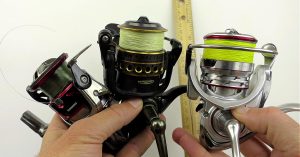Properly spooling line on a spinning reel is an essential skill for any angler. Incorrectly loaded line can cause tangles, reduce casting distance, and ruin a good day of fishing. Follow these best practices to ensure your spinning reel performs smoothly every time.
Why Proper Spooling Matters
A well-spooled reel ensures:
- Tangle-Free Casting: Reduces wind knots and snarls.
- Improved Casting Distance: Proper tension helps achieve longer, smoother casts.
- Durability: Prevents line twist and extends the life of your fishing line.

Step-by-Step Guide to Spooling a Spinning Reel
Step 1: Gather Your Tools
You’ll need:
- A spinning reel
- A spool of fishing line (monofilament, fluorocarbon, or braided)
- Scissors or line cutters
- A pencil or spool holder (to hold the line spool)
Step 2: Prepare the Reel
- Clean the Spool: If the reel has been used, clean the spool to remove dirt or debris.
- Open the Bail: Flip the bail arm up to expose the spool.
Step 3: Attach the Line
- Tie the Knot: Use an arbor knot to secure the line to the spool.
- Trim Excess Line: Cut any tag ends to avoid snags.
Step 4: Load the Line
- Orientation Matters: Place the line spool flat, label side up, to match the natural twist of the line.
- Apply Tension: Hold the line between your fingers as it enters the reel to ensure even spooling.
Step 5: Fill the Spool
- Don’t Overfill: Stop loading when the line is about 1/8 inch from the spool’s edge. Overfilling increases the risk of tangles, while underfilling reduces casting distance.
Step 6: Close the Bail
Manually flip the bail arm down to secure the line. Avoid using the reel handle to close the bail, as this can twist the line.
Common Mistakes to Avoid
Incorrect Line Direction
Ensure the line feeds off the spool in the same direction as the reel spins to prevent twists.
Skipping the Tension Step
Without proper tension, the line may spool unevenly, leading to tangles.
Overloading the Spool
Too much line increases the risk of backlash and reduces reel performance.
Pro Tips for Better Spooling
- Use Line Conditioner: Spraying a line conditioner while spooling reduces memory and ensures smoother casts.
- Test the Drag: Once spooled, test the drag setting to ensure it’s not too tight or loose.
- Check for Twists: After spooling, cast a few practice throws to detect any twists or tangles.
When to Replace Line
- Frequency: Replace monofilament and fluorocarbon every 3–6 months if heavily used. Braided lines can last longer but should be checked for frays.
- Signs of Wear: Replace the line if you notice discoloration, weak spots, or memory coils.
Mastering the art of spooling ensures your spinning reel performs flawlessly, giving you a competitive edge on the water. With these tips, you’ll spend less time dealing with tangles and more time reeling in the big catch.
Image: saltstrong





